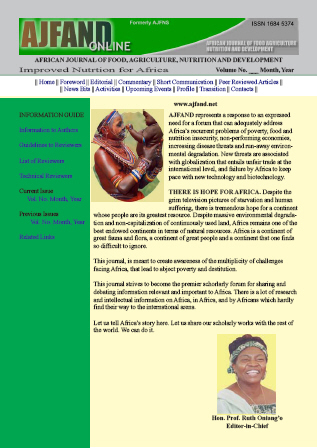
|
African Journal of Food, Agriculture, Nutrition and Development
Rural Outreach Program
ISSN: 1684-5358
EISSN: 1684-5358
Vol. 20, No. 2, 2020, pp. 15490-15508
|
 Bioline Code: nd20021
Bioline Code: nd20021
Full paper language: English
Document type: Research Article
Document available free of charge
|
|
|
African Journal of Food, Agriculture, Nutrition and Development, Vol. 20, No. 2, 2020, pp. 15490-15508
| en |
DIETARY DIVERSITY OF REPRODUCTIVE AGE WOMEN IN THREE SOUTH-EASTERN STATES OF NIGERIA
Onyeji, GN & Sanusi, RA
Abstract
Malnutrition has been an important public health problem in developing countries,
especially among women of reproductive age. Dietary diversity and favorable nutritional
status have been demonstrated to have a relationship with the quality of diets. Diets that
are low in fat and sugars and rich in fruits, vegetables, and wholegrain foods may help
reduce the risk of chronic diseases. Information on dietary intakes and dietary diversity
of women across Nigeria is scarce. This study was conducted to assess dietary diversity,
of diets of women of reproductive age in the South-eastern States of Nigeria. This study
was descriptive cross-sectional in design with a four-stage sampling technique used to
select women of reproductive age from three of the five states in the South-eastern States
of Nigeria. Three Local Government Areas were randomly selected from the three
senatorial districts of each state. From the nine Local Government Areas, 36 rural and 18
urban communities were randomly selected. A total of 1200 women of reproductive age
15-50 years participated in the study after giving informed consent. A pretested semi-structured
interviewer-administered questionnaire was used to collect data on
demographic and socio-economic characteristics. Multiple 24-hour diet recall, weight
and height measurements were conducted. The nutritional status of the respondents was
assessed with the use of anthropometric indices, weight (kg) and height (m) to estimate
the Body Mass Index (BMI), which was classified as underweight (<18.5 kg/m2), normal
(18.5-24.9 kg/m2), overweight (25.0- 29.9 kg/m2) and obese (≥30.0 kg/m2). Dietary
diversity was determined using a 14 food-group dietary diversity tool and terciles were
created to categorize individual dietary diversity (low: 1-4; average: 5-9; high: 10-14).
The mean age of women participants was 28.2 ± 5.6 years and BMI was 26.8 ± 4.8 kg/m2.
Most (96.3%) women of reproductive age were married; 41.7% were traders while 54.9%
completed secondary school education. Overall Dietary Diversity Score (DDS) was 7.0
± 1.8 and 7.6% scored low, 84.6% average, and 7.8% high. Overall DDS in the three
states were similar (p>0.05), however, the percentage with the low score was
significantly higher in the rural sector (9.8%) compared to the urban sector (3.0%).
Average dietary diversity found in these states indicates the average variety in dietary
intake. Therefore, to enhance dietary diversity in Nigeria, public health messages should
encourage and emphasize the production and consumption of diverse foods.
Keywords
Dietary diversity; Diet recall; Women; Reproductive age; South-eastern Nigeria
|
| |
© Copyright [2020] - African Journal of Food, Agriculture, Nutrition and Development
Alternative site location: http://www.ajfand.net/
|
|
